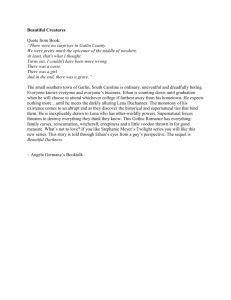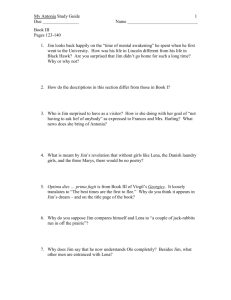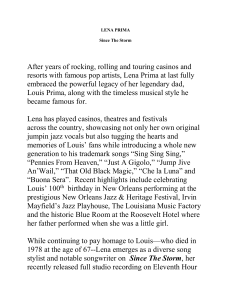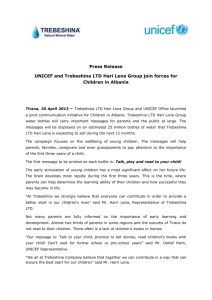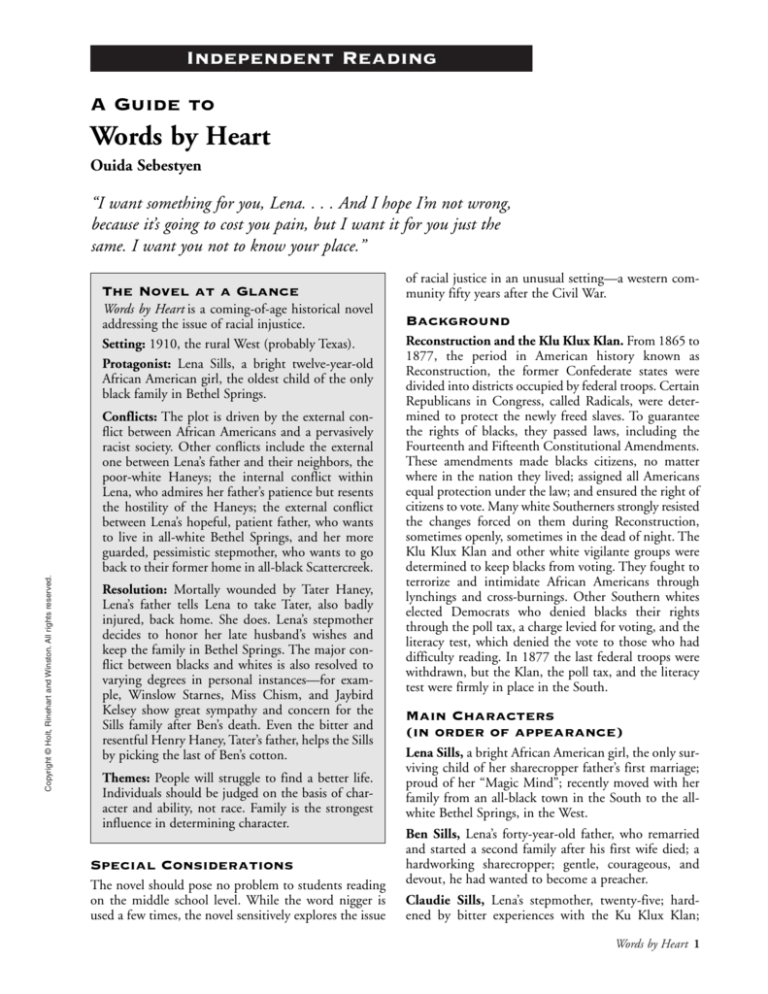
Independent Reading
A Guide to
Words by Heart
Ouida Sebestyen
“I want something for you, Lena. . . . And I hope I’m not wrong,
because it’s going to cost you pain, but I want it for you just the
same. I want you not to know your place.”
The Novel at a Glance
Words by Heart is a coming-of-age historical novel
addressing the issue of racial injustice.
Setting: 1910, the rural West (probably Texas).
Protagonist: Lena Sills, a bright twelve-year-old
African American girl, the oldest child of the only
black family in Bethel Springs.
Copyright © Holt, Rinehart and Winston. All rights reserved.
Conflicts: The plot is driven by the external conflict between African Americans and a pervasively
racist society. Other conflicts include the external
one between Lena’s father and their neighbors, the
poor-white Haneys; the internal conflict within
Lena, who admires her father’s patience but resents
the hostility of the Haneys; the external conflict
between Lena’s hopeful, patient father, who wants
to live in all-white Bethel Springs, and her more
guarded, pessimistic stepmother, who wants to go
back to their former home in all-black Scattercreek.
Resolution: Mortally wounded by Tater Haney,
Lena’s father tells Lena to take Tater, also badly
injured, back home. She does. Lena’s stepmother
decides to honor her late husband’s wishes and
keep the family in Bethel Springs. The major conflict between blacks and whites is also resolved to
varying degrees in personal instances—for example, Winslow Starnes, Miss Chism, and Jaybird
Kelsey show great sympathy and concern for the
Sills family after Ben’s death. Even the bitter and
resentful Henry Haney, Tater’s father, helps the Sills
by picking the last of Ben’s cotton.
Themes: People will struggle to find a better life.
Individuals should be judged on the basis of character and ability, not race. Family is the strongest
influence in determining character.
Special Considerations
The novel should pose no problem to students reading
on the middle school level. While the word nigger is
used a few times, the novel sensitively explores the issue
of racial justice in an unusual setting—a western community fifty years after the Civil War.
Background
Reconstruction and the Klu Klux Klan. From 1865 to
1877, the period in American history known as
Reconstruction, the former Confederate states were
divided into districts occupied by federal troops. Certain
Republicans in Congress, called Radicals, were determined to protect the newly freed slaves. To guarantee
the rights of blacks, they passed laws, including the
Fourteenth and Fifteenth Constitutional Amendments.
These amendments made blacks citizens, no matter
where in the nation they lived; assigned all Americans
equal protection under the law; and ensured the right of
citizens to vote. Many white Southerners strongly resisted
the changes forced on them during Reconstruction,
sometimes openly, sometimes in the dead of night. The
Klu Klux Klan and other white vigilante groups were
determined to keep blacks from voting. They fought to
terrorize and intimidate African Americans through
lynchings and cross-burnings. Other Southern whites
elected Democrats who denied blacks their rights
through the poll tax, a charge levied for voting, and the
literacy test, which denied the vote to those who had
difficulty reading. In 1877 the last federal troops were
withdrawn, but the Klan, the poll tax, and the literacy
test were firmly in place in the South.
Main Characters
(in order of appearance)
Lena Sills, a bright African American girl, the only surviving child of her sharecropper father’s first marriage;
proud of her “Magic Mind”; recently moved with her
family from an all-black town in the South to the allwhite Bethel Springs, in the West.
Ben Sills, Lena’s forty-year-old father, who remarried
and started a second family after his first wife died; a
hardworking sharecropper; gentle, courageous, and
devout, he had wanted to become a preacher.
Claudie Sills, Lena’s stepmother, twenty-five; hardened by bitter experiences with the Ku Klux Klan;
Words by Heart 1
Tater Haney, oldest son of an alcoholic ex-cowboy;
proud and strongheaded, he is resentful of Ben Sills, who
has been given the job from which his father was fired.
Jaybird Kelsey, storekeeper and church deacon; kindly
but sometimes foolish.
Winslow Starnes, white boy about Lena’s age; her chief
competitor at school; son of the town’s undertaker.
Mrs. Chism, elderly widow of the town’s wealthiest
man and employer of Lena’s parents; lonely, selfish, and
foolish, but not unfeeling.
Henry Haney, Tater’s father, an alcoholic, dirt-poor,
irresponsible ex-cowboy; resents Ben Sills for having
replaced him as Mrs. Chism’s hired hand.
Plot
Chapter One. We are introduced to the setting and
most of the major characters. Lena Sills is on her way
to a Bible-verse contest, with her father, stepmother,
and little half-siblings. Having recently moved to
Bethel Springs, a small Western town in which they are
the only blacks, Lena’s family hasn’t “mingled much”
with their neighbors. Foreshadowing the novel’s main
conflict, Tater Haney snubs them because Ben took a
job from which Tater’s drunk father was fired. Lena,
proud of her intellectual accomplishments, is determined to win the Bible competition. Standing before
the entire town, she matches the local favorite, Winslow
Starnes, verse for verse. The master of ceremonies offers
the two competitors a draw, but Lena wants to go on.
Chapter Two. A triumphant Lena wins the contest but
angrily rejects her prize—a bow-tie obviously bought
for Winslow. When they come home from the competition, the family finds a butcher’s knife stabbed
through a loaf of bread. Claudie angrily remarks that
Lena’s victory has “pushed a white town too fast.” This
symbolic stabbing sets the main conflict in motion and
foreshadows violence. Hurt and confused by her stepmother’s reaction, Lena seeks an explanation of the situation from her adored father, who gently says that
Claudie grew up in the South, where her family was
mistreated. Claudie felt safe in Scattercreek and is worried that new horrors await her family in Bethel
Springs. Ben tries to comfort Lena, who feels she has
done wrong in winning the competition. Giving voice
to one of the novel’s themes, he tells Lena always to
strive “to be better than yourself.”
Chapter Three. Ben displays the depth of his character and develops the theme of family by telling Lena, at
Claudie’s insistence, of the racial injustice and desire for
a better future that led him to move the family to
Bethel Springs. As they walk together through the field,
Ben explains that he grew up in “free” Kansas. When
Kansans felt threatened by the migration of blacks,
2 Words by Heart
however, his family was forced to move back to the
South, where blacks were being denied hard-won
rights. He eventually opted for the security of all-black
Scattercreek but didn’t “feel proud” of himself there and
so brought his family west to Bethel Springs. Ben tells
Lena that Claudie, frightened by the knife incident,
wants to return to Scattercreek. He then breaks the sad
news to her that their dog has been killed, probably by
Tater Haney, who is also suspected in the incident with
the bread. When Lena and her father return from their
walk, they find some joy—new kittens at home. The
next week Lena is to begin work. Later, when Lena
expresses her worry about missing school to work for
Mrs. Chism, Claudie retorts that her gentle father faces
a “life and death” problem—deciding what he would
do if someone were to hurt his family.
Chapter Four. Lena goes to clean for the proud Mrs.
Chism, a lonely and garrulous woman. She is entranced
by the stacks of books at the house, but Mrs. Chism
wants to sell them and won’t lend them. Lena slips a
book into her satchel and later implies to her father that
Mrs. Chism lent it to her.
Chapter Five. When Lena turns her homework in at
school, Winslow spies the atlas she “borrowed” and
teases her by grabbing it. Mortified, yet attracted by his
laugh, she snatches the book back and runs to Mrs.
Chism’s. Lena returns the atlas, which she read late into
the night, and “borrows” a poetry collection. We meet
a new character when Henry Haney shows up late for
a job; Mrs. Chism humiliates him and praises Ben,
making Lena uneasy.
Chapter Six. In a chapter filled with trouble and
mishap, Mrs. Chism asks Ben to leave his family and
make the long ride out to Hawk Hill to check on her
fences, a job formerly done by Henry Haney. Mrs.
Chism won’t accept Ben’s refusal. That night, little Roy
spills milk on the poetry book, and Lena has to admit
that she took it without permission. After a discussion
about the “borrowing,” Ben and Lena stop at the
Haneys’ to pick up Mrs. Chism’s fencewire and posts.
In a scene tense with potential conflict, Henry Haney
claims not to believe that the fencing job has been taken
from him. He says he will ride over to question Mrs.
Chism but then heads the opposite way.
Chapter Seven. Still at the Haneys’, Ben tries to look
for the fencewire and posts, which he suspects Haney
has sold. Conflict flares when Tater Haney threatens
Ben, pushing the barn door against him. Lena—her
father’s avenging angel—hits the boy in the stomach
with her satchel, heavy with the poetry book. Ben and
Lena then head to Mrs. Chism’s, where Lena confesses
to having taken the book. Ben calms the angry old
woman by assuring her that Claudie will help her with
her big dinner party on Sunday. After doing some
cleaning, Lena learns that her father and Mrs. Chism
have made an agreement: He will fix her fences
at Hawk Hill if she will give Lena her books. Lena is
Copyright © Holt, Rinehart and Winston. All rights reserved.
married to Ben Sills for seven years, she has borne two
sons and a daughter.
worried about Tater Haney’s threat to her father and the
fact that the fencing job will take him a few days’ distance from home. Ben reassures her that getting her
books is important to him. Heading home, they see
Henry Haney spying on them.
Chapter Eight. Lena is finally back at school, where
the children torment little Sammy Haney by stealing
the turnip that is his daily lunch. Lena, who has
climbed up a tree to eat her lunch, offers Sammy some
food, but he angrily refuses her charity. Winslow
Starnes, however, showing another side of his character, observes her kindness and joins her in the tree.
They start to become friends.
Chapter Nine. On Saturday Lena picks cotton in the
field, which she finds hard work, while the little ones
play nearby. Claudie, who is helping Mrs. Chism prepare for her party, is disturbed and bewildered by Ben’s
accepting the fence job. Ben hasn’t told her about trading his labor for Lena’s books. Later, Lena sees Claudie
cry that night in bed, as Ben comforts her.
Copyright © Holt, Rinehart and Winston. All rights reserved.
Chapter Ten. Claudie helps Mrs. Chism with her
party, but, despite the many invitations sent out to family and friends and the heaps of food, only Jaybird
Kelsey comes. Lena visits Mrs. Chism to cheer her up,
but the old woman, drunk and pitiful, treats Lena
rudely and smashes the fern Mr. Kelsey brought.
Patiently, Lena cleans up after her and goes home.
Chapter Eleven. On Monday Ben bids good-bye to his
anxious family and sets out to check the fences at Hawk
Hill. At Lena’s school the novel’s larger conflict is developed as the schoolmaster discusses the “obvious” superiority of the Caucasian race. Winslow provokes him by
asking about remarkable African Americans. With Lena
feeling she has an ally in Winslow, the next day she
learns that his father has forbidden him to associate
with her. That night, when Claudie is out rounding up
a wayward cow, a drunk Henry Haney barges into the
house looking for Ben. Lena refuses to show the fear she
feels. Humiliated, Tater Haney leads his father away.
When Claudie comes home with a pumpkin, Lena
expresses her feelings by carving an angry jack-o’lantern. Claudie, who is more worried about Tater than
about his father, tells Lena how the Ku Klux Klan
burned her family’s home. She also tells her daughter
how much Ben wants her to know he loves her, again
forwarding the theme of family.
Chapter Twelve. On Wednesday suspense builds when
Ben does not return home. Worried, Lena checks the
Haneys’ and sees Henry, but not Tater or Henry’s horse.
Lena puts on a brave front for the little ones but confides her fears to Claudie. Late that night, struggling
with her internal conflict, Lena decides to look for her
father. She writes a note to Claudie and slips out on
foot. Following Ben’s wagon tracks, she notices on her
second day of travel that the tracks are joined by the
hoofprints of a horse. Finally, she comes upon her
father’s wagon and horses; all his gear is scattered, and
he is nowhere in sight. She spots a plume of smoke in
the distance and, terrified, drives the wagon toward it.
Chapter Thirteen. In the novel’s climax, Lena finds
her father wounded beside an unconscious Tater
Haney. Tater shot Ben in the chest. Startled by the gunshot, the horse threw Tater, who is badly injured. Ben
gently tells Lena that he is dying but that he feels lucky
she has found him. Since Tater’s life can be saved, Ben
tells her to take him home in the wagon. Then he asks
her to leave him alone for a while, which in turn leaves
Lena alone to struggle against her desire for vengeance.
When she returns, her father has died. Although
crushed and angry, Lena knows what her father would
expect of her—to do good to those who hate her.
Finally, resolving her internal conflict, Lena gets Tater
onto the wagon and drives him home.
Chapter Fourteen. After leaving Tater with his mother,
Lena brings Ben’s body to Claudie, telling her mother
she “can’t remember” who shot him. Knowing the identity of Ben’s killer, Claudie accepts Lena’s refusal to tell.
After sleeping many hours, Lena wakes to find the
preacher and Jaybird Kelsey at her house, along with
Mrs. Chism. Winslow Starnes has come too, defying
his father. Lena tells Claudie that she is willing to go
back to Scattercreek, but Claudie decides to stay in
Bethel Springs in honor of Ben’s wishes. In the novel’s
resolution, Lena sees Henry Haney picking the last of
Ben’s cotton for them. Although he may be doing it to
keep Lena from telling on Tater, she hopes he’s there for
a better reason.
Approaches for
Post-Reading Activities
An outstanding element of this novel is character—the
relationship between Lena’s developing character and
her father’s heroic one. Discussion groups or students
doing individual research projects might focus on the
following activities.
1. Exploring the Novel’s Characters
Students will probably be most affected by the heroism of Ben’s character and Lena’s internal struggle to
emulate her adored father, especially after his death.
The novel’s focus on character helps develop the
theme that people should be judged as individuals,
not as members of a particular race. The following
activities can help students explore Sebestyen’s characters. Ask students to
• develop a dialogue between Lena and Winslow, in
which Lena tells Winslow how her father died and
how she behaved at the time.
• write a letter from Ben to Lena that tells her how
he feels about her and how he would like her to
regard his death in years to come.
• outline Lena’s future. Where does her “Magic
Mind” take her?
Words by Heart 3
2. Evaluating Credibility and Relevance
Discussion groups might focus on other specific elements of the novel:
• How believable is the situation of the plot? In the
resolution, are the actions of Lena, Claudie,
Winslow Starnes, and Henry Haney believable?
Why or why not?
• How do the novel’s conflicts connect with news
stories, movies, or TV dramas you are familiar with?
• Does the novel seem primarily optimistic or pessimistic about relations between blacks and whites?
Explain.
3. Extending the Novel
Discussion groups might extend ideas in the novel:
• Words by Heart is set eighty years ago. Ask students
to discuss the ways in which the Sills’ experience as
the only African American family in a community
would be different today.
• Today some minority groups make strong arguments
for choosing virtual separation from other groups
(Claudie’s perspective), while others argue that only
full integration brings equality (Ben’s perspective).
Ask students to discuss the merits of each argument.
ing early, finishing her first novel (unpublished) at
twenty. In all she submitted four novels to publishers
before Words by Heart was finally accepted for publication. The book received a number of awards, including
the American Book Award and the International
Reading Association Children’s Book Award.
Read On
Ouida Sebestyen, Far from Home. In this Depressionera novel, a thirteen-year-old boy takes over his
mother’s job at a hotel after her death and learns new
lessons about family love.
Mildred D. Taylor, The Well: David’s Story. In this
novel set in Mississippi in the early 1900s, the family of
ten-year-old David shares its well with drought-stricken
white and black neighbors.
Blanche Hannalis, The Secret Garden. This play,
based on the famous novel by Frances Hodgson
Burnett, shows how love and determination help a bitter orphan and a lonely boy to create a loving home and
family.
Ouida Sebestyen (1924– ) grew up in a small town
in Texas, the daughter of two teachers. She widened her
world by reading everything she could and began writ-
Clifton Davis, “A Mason-Dixon Memory.” A group
of friends refuses to give in to bigotry in this moving
nonfiction account.
Copyright © Holt, Rinehart and Winston. All rights reserved.
Meet the Writer
Mildred D. Taylor, “The Gold Cadillac.” In this realistic short story, a family faces racism when they travel
South in an expensive new car to visit relatives.
Copyright © by Holt, Rinehart and Winston, Inc.
All rights reserved. No part of this publication may be reproduced
or transmitted in any form or by any means, electronic
or mechanical, including photocopy, recording, or any information
storage and retrieval system.
Printed in the United States of America
4 Words by Heart


